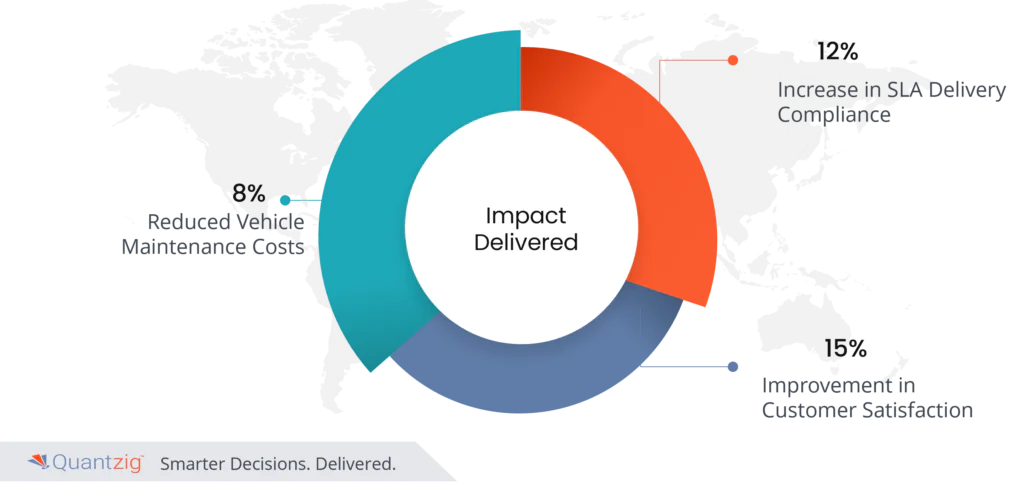In the ever-evolving landscape of fleet management, staying ahead of the curve is crucial for optimizing operational efficiency. Predictive analytics has emerged as a powerful tool, offering fleet managers invaluable insights into their operations. By harnessing the capabilities of predictive analytics in operations analytics, organizations can make data-driven decisions, reduce costs, enhance safety, and streamline overall fleet performance. Additionally, integrating key fleet management systems with predictive analytics can significantly amplify these benefits.
Table of Contents
Importance of Predictive Analytics in Fleet Management
The importance of predictive analytics in fleet management cannot be overstated, as it plays a crucial role in enhancing operational efficiency, reducing costs, ensuring safety, and optimizing overall fleet performance. By leveraging both historical and real-time data, predictive analytics empowers data-driven decision-making, allowing fleet managers to make informed choices that improve strategic planning and operational outcomes.
A major benefit of predictive analytics is operational efficiency, achieved through advanced route optimization and predictive maintenance. These tools streamline operations, reduce downtime, and ensure optimal use of resources. When integrated with robust fleet management systems, these capabilities are further enhanced, resulting in smoother and more efficient workflows.
Cost reduction is another significant advantage. By optimizing fuel consumption and accurately forecasting maintenance needs, fleets can realize substantial savings on fuel and repair expenses, directly improving profitability. At the same time, resource optimization ensures the effective allocation of vehicles, drivers, and maintenance facilities. Insights into usage patterns and demand forecasts enable better planning and asset utilization.
Safety enhancement is also a key outcome of predictive analytics. By analyzing driver behavior, companies can identify risky practices and implement targeted training, creating a safer working environment and reducing the likelihood of accidents. This, in turn, supports greater customer satisfaction, as timely deliveries, fewer service disruptions, and consistent performance contribute to a more positive customer experience and stronger brand reputation.
In terms of compliance management, predictive analytics helps monitor adherence to safety standards and regulatory requirements, minimizing the risk of fines and legal issues. It also facilitates proactive maintenance, enabling a shift from reactive responses to predictive strategies. This not only prevents breakdowns but also extends the lifespan of vehicles.
From an environmental standpoint, predictive analytics supports sustainability by optimizing routes and improving fuel efficiency, which leads to lower fuel consumption and reduced emissions.
Collectively, these benefits provide a powerful competitive advantage, enhancing agility, responsiveness, and overall cost-effectiveness. By adopting predictive analytics in fleet management, organizations position themselves as leaders in an increasingly competitive and data-driven industry landscape.
Challenges in Predictive Analytics in Fleet Management
The implementation of predictive analytics in fleet management is not without its challenges. Two prominent challenges revolve around the volatile nature of both the market and customer needs, as well as the complex scale of managing multiple assets within a fleet.
Security and Privacy Concerns: With the increasing reliance on data-driven technologies, ensuring the security and privacy of sensitive fleet information becomes paramount. The potential for data breaches and unauthorized access poses a significant challenge.
Volatile Market and Customer Needs: The transportation industry operates in a dynamic environment where market trends and customer needs can change rapidly. Predicting future demands and market fluctuations becomes challenging due to external factors such as economic conditions, regulatory changes, and evolving customer expectations.
Scale and Complexity in Fleet Management: Fleet management involves overseeing a multitude of assets, including vehicles, drivers, maintenance facilities, and more. The sheer scale and complexity of managing a large fleet can overwhelm traditional management systems, making it difficult to derive actionable insights from the vast amount of data generated.
Data Quality and Integration: Predictive analytics relies heavily on the quality of data. In fleet management, data may be sourced from various systems, and ensuring its accuracy, consistency, and completeness can be challenging. Integrating data from different sources and formats adds another layer of complexity.
Driver Adoption and Training: Successfully implementing predictive analytics requires buy-in from the workforce, especially drivers. Resistance to new technologies and a lack of understanding about how predictive analytics can benefit daily operations may hinder successful implementation.
Cost of Implementation: Implementing predictive analytics solutions often involves significant upfront costs. This includes investments in technology infrastructure, data management systems, analytics tools, and staff training.
Benefits of implementing Predictive Analytics in fleet management

- Route Optimization: Predictive analytics enables fleet managers to analyze historical data, weather patterns, and traffic conditions to optimize routes. By anticipating potential obstacles and congestion, organizations can ensure that their vehicles take the most efficient paths, saving both time and fuel. This not only enhances operational efficiency but also minimizes environmental impact.
- Predictive Maintenance: Unplanned vehicle breakdowns can be a significant drain on resources and time. Predictive analytics allows fleet managers to predict when maintenance is needed based on factors such as vehicle usage, historical maintenance data, and real-time performance monitoring. By addressing potential issues before they become critical, organizations can reduce downtime, extend vehicle lifespan, and lower maintenance costs.
- Fuel Management: Fuel costs represent a substantial portion of a fleet’s operational expenses. Predictive analytics helps in optimizing fuel consumption by analyzing various factors, including driver behavior, vehicle performance, and fuel prices. By identifying inefficient practices and promoting fuel-efficient driving habits, organizations can achieve significant cost savings while reducing their carbon footprint.
- Driver Behavior Analysis: Understanding and improving driver behavior is crucial for both safety and operational efficiency. Predictive analytics can assess driver performance based on historical data and real-time monitoring. By identifying patterns of aggressive driving, speeding, or other risky behaviors, fleet managers can implement targeted training programs to enhance safety and reduce the likelihood of accidents.
- Inventory Management: For organizations managing large fleets of vehicles, inventory management is a complex challenge. Predictive analytics can help forecast demand for spare parts, tires, and other critical components. By ensuring that the right parts are available when needed, fleet managers can minimize downtime, optimize inventory levels, and improve overall operational efficiency. The integration of key fleet management systems enhances these predictive capabilities.
- Compliance Monitoring: Fleet operations are subject to various regulations and compliance standards. Predictive analytics can assist in monitoring and ensuring compliance with safety regulations, emissions standards, and other industry-specific requirements. By proactively addressing compliance issues, organizations can avoid fines, legal complications, and reputational damage.
- Cost Reduction: One of the primary advantages of predictive analytics fleet management is its potential to reduce overall operational costs. By optimizing routes, improving maintenance practices, and enhancing fuel efficiency, organizations can achieve significant savings. The ability to identify cost-saving opportunities through data-driven insights is a key benefit of incorporating predictive analytics into fleet operations.
Success Story:
Revolutionizing Logistics: Quantzig’s Predictive Maintenance Solution Rescues European Client from Vehicle Breakdown Woes
Client details:
In the fast-paced world of logistics, where timely deliveries are paramount, any disruption can have far-reaching consequences. A European client, despite investing in cutting-edge vehicles, found themselves grappling with the vexing issue of unexpected breakdowns. This not only led to delays in customer deliveries but also significantly impacted overall customer satisfaction. Enter Quantzig, with an innovative solution that not only addressed the immediate challenges but also brought about substantial improvements in operational efficiency.
Challenges Faced by the Client:
Our European client, a key player in the logistics industry, faced a persistent challenge of unexpected vehicle failures. Despite the infusion of newer and more sophisticated vehicles into their fleet, the specter of ad-hoc breakdowns loomed large. This not only disrupted their operational workflow but also posed a severe threat to customer satisfaction levels. The client recognized the urgent need for a solution that could predict potential breakdowns, allowing for strategic planning and proactive measures to avoid Service Level Agreement (SLA) breaches.
Solutions Offered by Quantzig:
Quantzig’s team of experts crafted a customized solution in the form of a centralized vehicle breakdown prediction engine. This cutting-edge system leveraged a holistic approach, considering factors such as weather conditions, road conditions, vehicle health, historical performance data, and maintenance activities. The cornerstone of this solution was the utilization of near real-time Internet of Things (IoT) sensor data from various vehicle parts.
The prediction engine analyzed deviations and deterioration in vehicle parts by juxtaposing the real-time sensor data with historical information. This allowed the client to identify potential breakdowns before they could escalate into critical issues, enabling them to proactively address maintenance needs.
Impact Delivered:

Quantzig’s predictive maintenance solution delivered tangible and transformative results for our European client:
- 8% Reduced Vehicle Maintenance Costs: By proactively addressing maintenance needs and averting unexpected breakdowns, the client experienced a significant reduction in overall vehicle maintenance costs.
- 12% Increase in SLA Delivery Compliance: The predictive maintenance engine enabled the client to plan and allocate resources more efficiently, leading to a remarkable 12% increase in compliance with Service Level Agreements for customer deliveries.
- 15% Improvement in Customer Satisfaction: With fewer disruptions, timely deliveries, and an optimized fleet, the client witnessed a substantial 15% improvement in customer satisfaction levels.
Conclusion: Paving the Way for Operational Excellence
Quantzig’s tailored predictive maintenance solution not only addressed the pressing challenges faced by our European client but also ushered in a new era of operational excellence. By harnessing the power of data-driven insights and real-time IoT analytics, the client successfully mitigated the impact of unexpected breakdowns, optimized their fleet management, and elevated customer satisfaction to new heights. This success story stands as a testament to the transformative potential of innovative solutions in overcoming complex operational challenges within the logistics industry.



